What is Granite?
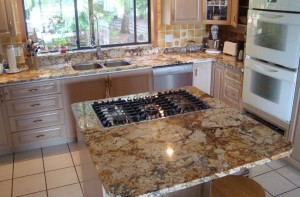 Mercantile granites are classified as non-calcium based stones that will polish to a bright shine. They range in hardness between 6 and 9 on the Moh scale and are all harder than metal.
Mercantile granites are classified as non-calcium based stones that will polish to a bright shine. They range in hardness between 6 and 9 on the Moh scale and are all harder than metal.
Because of their hardness, durability and easy maintenance, these stones make really great kitchen counter tops.
Although true geologic granites also belong to this group of stones, most mercantile granites are not true geologic granites, but rather metamorphic rocks.
These stones could vary tremendously in color and pattern and could contain inclusions of garnet or labradorite, to name but a couple of minerals.
Granite countertops truly are jewelery for your home!
Benefits of Stone
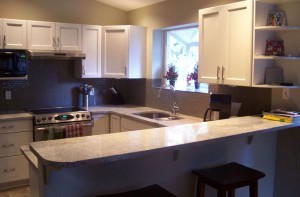 Aside from its durability and looks, stone offers a much greater contribution to your counter top: health.
Aside from its durability and looks, stone offers a much greater contribution to your counter top: health.
March of 1999 the Hospitality Institute of Technology and Management (HITM) did a study on the cleanliness of various common counter top surfaces. This test was lead by O. Peter Snyder Jr., Ph.D. and its aim was to determine the suitability of different counter top surfaces for food preparation, specifically for the hospitality industry.
A number of common food preparation surfaces were contaminated with E. coli bacteria, tested for density of bacteria population, wiped clean with dish soap, rinsed and re-tested to determine how much bacteria was removed. Granite scored tops after initial testing, and was only barely outperformed by stainless steel after a second cleaning with a vinegar solution.
The full report of this study could be found at the website for the Hospitality Institute of Technology and Management.
Testing Your Stone
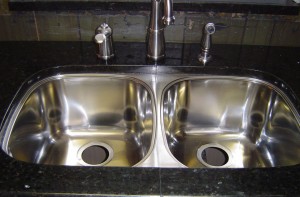 It is a little known fact that not all stones need to be sealed. Once you have found a material that you like, it is fairly easy to determine if the stone would be suitable for your specific application. Natural stone is a wonderful material and selecting the appropriate stone will ensure you years of worry free enjoyment of your investment.
It is a little known fact that not all stones need to be sealed. Once you have found a material that you like, it is fairly easy to determine if the stone would be suitable for your specific application. Natural stone is a wonderful material and selecting the appropriate stone will ensure you years of worry free enjoyment of your investment.
First we need to explain the purpose of applying sealer to stone: A sealer is, in essence, particles of a solid matter dissolved in a transport medium or solvent. Once you have applied the sealer to a surface, the sealer will penetrate the stone and the solvent will evaporate, leaving only the solids in the pores of the stone. This in turn will prevent the further absorption of liquids.
The only purpose of a sealer is to prevent staining by preventing absorption. Sealers DO NOT prevent scuff marks, wear and tear or chemical reactions and do not change the physical characteristics of the stone.
Water Absorption Test
To find out if your stone would require sealer, you can do the water absorption test:
Using a sample piece of the stone in question, drip some water on it. Leave the water for a while and then wipe it with a blotting motion.
If there are any dark spots where the water drops were, it means that your stone sample absorbed the liquids and would benefit from the application of a good quality sealer.
Acid Test
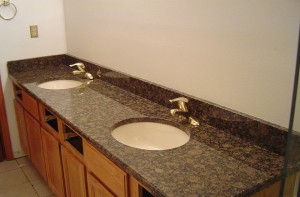 Another very important thing to know about your prospective kitchen counter top, is whether it would react to acids or not. As mentioned before, no impregnating sealer would prevent etching (the damage caused when an acid reacts with calcium) Since it is a chemical reaction, it is not dependent on absorption to occur. There is also no DIY fix for an acid etched stone, and if such damage would bother you, the only way to fix it would be to hire a knowledgeable stone restoration professional.
Another very important thing to know about your prospective kitchen counter top, is whether it would react to acids or not. As mentioned before, no impregnating sealer would prevent etching (the damage caused when an acid reacts with calcium) Since it is a chemical reaction, it is not dependent on absorption to occur. There is also no DIY fix for an acid etched stone, and if such damage would bother you, the only way to fix it would be to hire a knowledgeable stone restoration professional.
To do the test, you need a fresh lemon or lime, cut in wedges. Leave a wedge or two – cut side down – on the stone overnight. Remove the wedge in the morning and leave the stone to dry. Look at where the wedge lay – if you can see any dullness, a break in the reflection or can actually feel a rough spot, you have an acid etch. The marks, if present, will also be lighter than the stone.
Repair and Maintenance
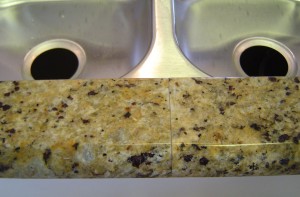 It is not widely known, but most problems with natural stone are realtively fixable!
It is not widely known, but most problems with natural stone are realtively fixable!
At Mid-Island Granite we can solve most common stone mishaps: chips, fissures or scratches are all easily repairable.
Even misdeeds by unscrupulous or inexperienced stone people could be made to look better to some degree: bad seams, poor edge polishing or cracked stone could be improved to some extent.
